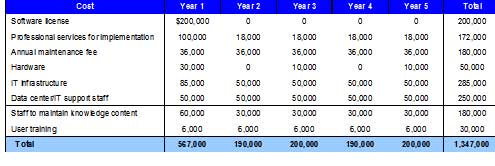Customer service is one of those topics that engender passionate calls to action at staff meetings, but little follow-through. Why? Because it’s tedious work, difficult to measure, and expensive. Yankee Group estimates the total cost of a $200,000 Web-based self-service application is $1.3 million over five years, including IT support, knowledge-based maintenance, user training, and so on (see Table 30, below).
However, if you expect to profit from your online services, you must pay attention to the subject. Following are several tables to help you prioritize your investments. Table x lists the high-level priorities. Table y lists 10 ways to get the biggest bang for your buck today. Finally, we list more than 50 techniques for delivering service beyond customer expectations, while deflecting calls from your call center and branches.
Online Service Rules
# 1: Anticipate questions and tripping points;
remove the ambiguity in the product-design phase
# 2: Email users frequently with confirmations and alerts, especially for new accounts in process
# 3: Imbed pop-up Help bubbles for every conceivable question, especially in product applications
# 4: Make sure customer service owns the FAQs,
including the authority/ability to change them on the fly
# 5: Provide prominent Search capabilities;
manage the results to insure relevancy
# 6: Most people still want to want to interact with a live human; put a face on your e-service, and don’t hide phone numbers
Source: Online Banking Report, 3/04
Table 30
Total Cost of Ownership
stand-alone Web self-service solution

Source: Yankee Group, 8/02, from Online Selling & eCRM
Table 31
Strategic E-Service Priorities

Source: Online Banking Report, 3/04
Table 32
Ten Low-Cost E-Service Improvements
1. Autoresponse email to Web-based inquiries
2. Help button on every page, especially at login
3. Expanded FAQs, possibly with college intern support
4. Links to FAQs in email responses
5. FAQs written in user-friendly language
6. Published email service standards
7. Opt-in for email communications when submitting Web-based inquiries
8. Templates for email responses
9. E-reps rewarded for improving online FAQs
10. On-hold message referring users to easy to remember URL for Web-based inquiry,
e.g., <www.yourbankservice.com>, or use your toll-free number as the URL <www.1-800-555-BANK>
Source: Online Banking Report, 3/04
Table 33
Techniques for Deflecting Service Calls/Visits


Source: Online Banking Report, 4/04
Table 34
Basic E-Service Implementation Checklist
- Contact Us link in the upper-right corner of every Web page
- Ensure that common search terms entered in your site-search feature result in highly relevant answers and links
- Separate FAQs for customers and non-customers
- FAQs edited by a professional copy writer for grammar and tone; reviewed by customers for clarity
- Web-based inquiry form includes: name, email address, retype email address, customer/noncustomer, subject (choose from drop-down list), and opt-in for future email communications
- Inquiry form includes graphical security assurances and link to privacy and security policie
- Direct customer service email addresses; for example, [email protected], [email protected]
- Identifiable service area with its own intuitive URL; for example, <service.yourbank.com>, <vip.yourbank.com>, <www.yourbank.com/service>, <1800yourcallcenter.com>
- Service department Web and email addresses in company literature and advertising
- Autoresponses for Web-based queries, includes thank-you and estimated response time
- Email response templates for the most common questions
- Procedures for handling undeliverable emails
- Secure password-reset procedure and monitoring program
- Security/privacy guidelines for handling confidential information emailed by user
- Fraud-detection algorithms and procedures for email requests, e.g., password resets, change of address
- Procedures to escalate customer problems
- Guidelines for distributing email questions to the appropriate departments
- Tracking and follow-up mechanisms to ensure all emails are answered in a timely fashion
- Performance metrics and methods to capture the data, e.g., response times; percent resolved within 24/48/72 hours; customer satisfaction with response
- Service standards communicated internally and externally
- Process for maintaining and improving internal and external knowledge base and FAQs
- Guidelines and approval procedures for editing approved email response templates
- Email training program for e-reps, branch staff, and other customer-contact personnel
Source: Online Banking Report, 4/04